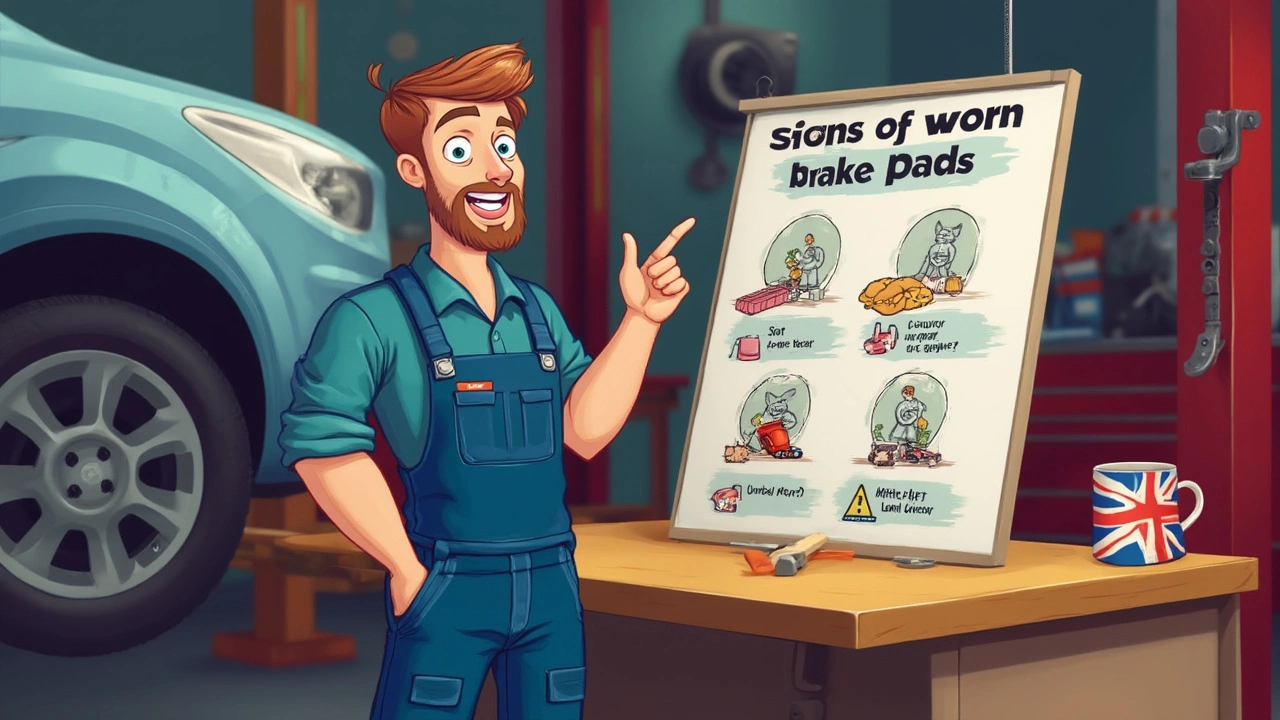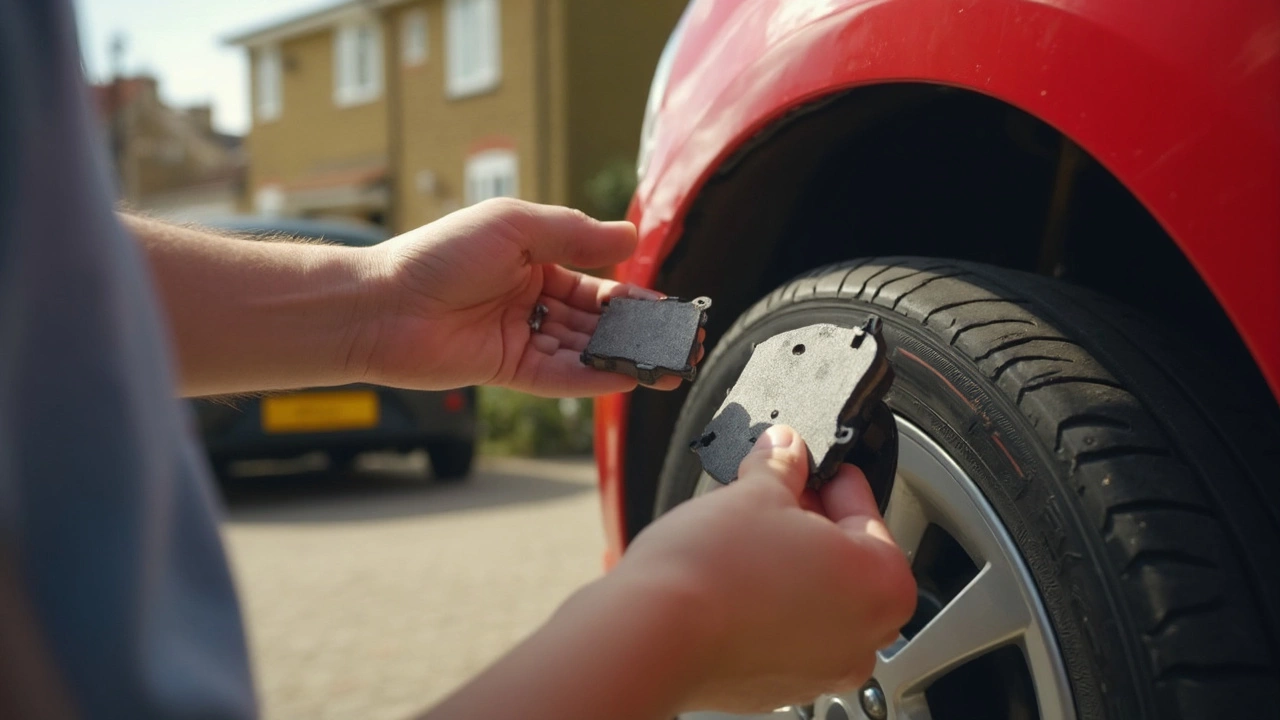Brake pads aren’t something most people think about until they start making weird noises. But your car's braking system is one of those things you don’t want to ignore. Driving with worn-out pads can get pricey—and unsafe—fast.
Some brake pads make it easy with those squealing sounds when they’re running low. But sometimes, there are warning signs people miss. Brakes that feel squishy, a shaky steering wheel, or even a burning smell can all mean your pads are begging to be swapped out. Not sure what counts as a ‘real’ problem? Stick around, because just guessing can mean you’re gambling with your safety.
- Why Brake Pads Wear Out
- Warning Signs You Can’t Ignore
- How to Physically Check Brake Pads
- Dash Lights and Tech Gadgets
- When to DIY or Call a Mechanic
- Tips for Making Brake Pads Last Longer
Why Brake Pads Wear Out
Your brake pads don’t last forever, no matter how careful you drive. Every time you tap the brakes, these pads press against your car’s metal rotors to slow down your wheels. This friction wears down the pad bit by bit, which is just how the system’s designed to work—so wearing out is normal.
How fast they wear depends on a few things. City drivers usually replace pads way more often than highway drivers. That’s because taking lots of short trips and stopping for traffic lights or in traffic jams works your brakes harder. People who drive mostly on open highways tend to get a lot more life out of their pads because they brake less.
The material your brake pads are made from is a big deal too. Most cars today use either ceramic or semi-metallic pads. Ceramics are quieter and last longer, but cost more. Semi-metallic pads are tougher on rotors and don’t usually last as long, but they’re a popular choice because they’re cheaper.
- Weight matters. Heavier cars (think SUVs and trucks) eat through pads quicker than smaller cars.
- Your driving style makes a huge difference. Hard braking—slamming on the brakes a lot—burns through pads fast. Coasting and braking gently saves them.
- Environment isn’t just a buzzword. If you drive a lot in the mountains or in rainy, muddy areas, your pads will wear down quicker. Water, dirt, and grit get in there and speed up the process.
Brake pads usually last between 25,000 and 70,000 miles, but that’s a big window. Check your owner’s manual, but don’t count on the car to tell you when it’s time. Conditions and habits matter more than the sticker.
| Type of Driving | Estimated Pad Life (miles) |
|---|---|
| City/Urban | 25,000 - 40,000 |
| Highway | 50,000 - 70,000 |
So if you mostly drive in the city, expect to replace those pads sooner. Staying alert to the common brake warning signs will go a long way in keeping you— and your wallet—out of trouble.
Warning Signs You Can’t Ignore
There are certain signals your car gives when brake pads are wearing down, and missing them could cost way more than just a new set of pads. The most famous one is the high-pitched squeal or screech—like nails on a chalkboard. This annoying sound happens because many modern pads have wear indicators that make noise when it’s time for a change. If you hear this sound every time you brake, it’s not your imagination; it’s a warning you can’t afford to ignore.
A grinding noise is even more serious. That usually means your brake pads are worn down to the metal. If you keep driving like that, you can ruin your rotors too, turning a simple pad swap into a much pricier repair. Grinding isn’t the only red flag to watch for either.
- Longer Stopping Distance: Are you pressing harder on the pedal or noticing it takes longer for your car to stop? That’s a classic sign your pads are probably thin and not gripping enough.
- Vibrations: If you feel your steering wheel or brake pedal shake when stopping, your pads could be uneven or your rotors might be warped from too-thin pads.
- Pulling: Is your car drifting to one side when you hit the brakes? That can point to uneven brake pad wear or a stuck caliper.
- Warning Lights: Many cars have a brake warning light. If it’s on, check your owner’s manual—sometimes it’s about the fluid, but it might also mean the pads are worn out.
- Burning Smell: Smell something weird after braking hard? That could mean your pads or calipers are overheating, sometimes due to excessive wear.
Here’s a quick look at the signals and what they mean. More than half of drivers admit they ignore brake warning signs until things get a lot worse—don’t be one of them!
| Warning Sign | What it Means |
|---|---|
| Squealing Noise | Wear indicators are exposed; pads are low |
| Grinding Sound | Pads are worn through; metal on metal contact |
| Longer Stopping | Less pad material left, reduced stopping power |
| Brake Warning Light | Possible low pads or fluid; check system ASAP |
No need to be a mechanic to spot these issues. Catching them early is the difference between a quick fix and a wallet-draining trip to the shop. So, if you notice any of these, it's time to think seriously about brake pad replacement for your car safety.
How to Physically Check Brake Pads
Sometimes your ears or warning lights just aren’t enough. To be sure about your brake pads, you’ve got to look for yourself. Good news: you don’t need to be a pro mechanic to do this right.
Most cars let you peek at the brake pads through the spokes of your wheel. If you can, shine a flashlight in there. The pad is the material pressed up against the metal rotor. A new brake pad is usually about 10–12mm thick. If what you see looks worn down to 3mm or less, it’s time for new ones. That’s not just a guess—anything below 3mm gets risky fast and most shops set that as the cutoff.
- Step 1: Park your car on level ground, turn off the engine, and set the parking brake.
- Step 2: Look through the wheel spokes. If you have to, remove the wheel for a closer look.
- Step 3: Find the brake pad. It sits inside a metal clamp (the caliper), just next to the metal rotor that spins with the wheel.
- Step 4: Check pad thickness. Compare what you see to the 3mm safety line. Thicker than a quarter? You’re good. Thinner? Swap them soon.
- Step 5: Look for odd wear—pads wearing down unevenly, or grooves cut deep into the pad or rotor. That means you might have bigger problems, like stuck calipers or misaligned brakes.
Some cars (especially older ones) don’t make this so easy. If your wheels have a design that blocks your view, just jack up the car and take the wheel off. It sounds like a pain, but it gives you the 100% clear picture you need before dropping cash on new parts.
Here’s a quick cheat sheet for typical pad thickness—and what it means:
| Pad Thickness | What To Do |
|---|---|
| 10–12mm | Brand new, long road ahead |
| 6–8mm | Still healthy, keep an eye on it |
| 3–4mm | Plan a replacement soon |
| Less than 3mm | Change ASAP for safety |
Physically checking your car maintenance items like pads doesn’t just save you money: it keeps you and your gear safe. Don’t wait for brakes to start grinding before taking a look.

Dash Lights and Tech Gadgets
Keen on catching brake problems before they go from bad to worse? Brake pads in a lot of modern cars come with built-in warning systems. If your dash lights up with a little yellow or red circle (sometimes with a “!” in the middle), don’t just ignore it. That’s your car’s way of shouting, “Check those brakes!”
Here’s the lowdown on what these notifications mean:
- Brake Warning Light: This usually looks like a circle with parentheses or the word “BRAKE.” It means your brake pad wear sensors have detected thin pads or another brake issue.
- ABS Light: Not about wear but tells you there might be a problem with your anti-lock braking system—still brake-related, so don’t brush it off.
- Service Light: Some fancier models combine pad wear alerts with a general reminder light. Check your car’s manual to be sure.
A lot of cars from 2010 onward throw these warnings at you when the brake pads hit a certain thinness, usually around 3mm left. For reference, when new, most pads are about 10-12mm thick. Here’s a quick cheat sheet:
| Pad Thickness | Status |
|---|---|
| 10-12mm | Brand new |
| 6-7mm | Still good |
| 3mm | Time to replace |
| <3mm | Replace ASAP |
If you’re driving an older or basic model, you might not have any warning lights at all. In that case, you’ll need to rely on old-school checks and listening for odd noises. For drivers with cars fitted with more car maintenance tech, some even send push notifications to your phone or show specific warnings in digital dash menus. The newer the ride, the more ways your car is trying to get your attention.
Quick tip: when a brake pads alert pops up, don’t just reset it or hope it’ll go away. Grab your manual or call your garage, because ignoring dash lights today could mean bigger fixes (and bills) tomorrow.
When to DIY or Call a Mechanic
Thinking about swapping your own brake pads? Plenty of car folks do their own pad replacements. It saves money and gives you a little extra street cred in the garage. But just because you watched a couple of YouTube videos, doesn’t mean it’s always a good idea for everyone.
If you’ve got basic tools, a safe spot to work, and some hands-on experience with cars, replacing brake pads can be a solid DIY job. Here’s when doing it yourself actually makes sense:
- You know how to safely jack up your car and remove wheels.
- You can spot the difference between pads and calipers.
- You have a way to compress the caliper piston and the right type of brake grease on hand.
- Your ride isn’t loaded with high-tech systems that need to be reset by computer after a pad change.
But let’s be real—not everyone has time or wants to risk maze-like brake systems. Here’s when it’s smarter to call a pro:
- You hear grinding or metal-on-metal sounds. By this point, your rotors might be wrecked, not just the pads.
- You see warning lights on the dash and aren’t sure why.
- Your car has electronic parking brakes or sensors, which need special tools or software.
- You don’t have a safe place to work or the job just sounds overwhelming.
One survey found that about 40% of car owners have tried replacing brake pads themselves at home, but half of those people later needed a pro to fix a mistake they made. So it’s not about pride—it’s about knowing your limits and keeping your car safety top of mind. Paying for a mechanic now is a lot cheaper than paying for a tow and new rotors later because something went wrong in the driveway.
If you’re ever in doubt, most garages will check your brakes for free. They make their money on the fixes, not the inspection, so asking for a second opinion won’t cost you.
Tips for Making Brake Pads Last Longer
Want your brake pads to go the distance? A lot of it comes down to how you drive and how you take care of your car. Heavy foot on the brake? That’s a fast way to wear them out. Let’s run through some dead simple ways to stretch their lifespan and keep more cash in your pocket.
- Go easy on the brakes. Don’t wait until the last second to stop. When you know you’ll need to slow down—say, at a red light or turning corner—start easing off the gas early and brake gently.
- Don’t ride the brakes downhill. It’s tempting to keep your foot on the brake to control speed, but that burns through pads fast. Use lower gears instead, so gravity does more of the work and you tap the brake less.
- Keep it light. Extra weight means your braking system works harder. Clear out heavy stuff from your trunk if you don’t need it. Got a roof box you only use once a year? Pop it off in between trips.
- Stick to regular car maintenance. Worn shocks, bad wheel alignment, and even old brake fluid can mess with how the pads wear. Stick to your mechanic’s schedule for oil changes, tire checks, and alignments.
- Flush the brake fluid. Dirty fluid traps moisture, leading to corrosion and sticky calipers. Replacing the fluid every couple years helps keep everything running smooth and pads from dragging.
Fact: Driving smart actually makes a big difference. According to a study from AAA, aggressive driving—think hard braking and stop-and-go city trips—can cut brake pad life by up to 40%. Swapping out stressful city driving for calm highway miles whenever you can is another sneaky way to save your brake pads.
| Driving Style | Average Pad Life (miles) |
|---|---|
| City, stop-and-go | 20,000–30,000 |
| Highway, gentle braking | 40,000–60,000 |
So next time you’re tempted to mash the brakes or ignore a weird sound, remember a few small habits now can keep your brake pads and wallet happier down the road.

